The pea puffer fish, scientifically referred to as Carinotetraodon travancoricus, can be found in the freshwater streams and rivers of India. These tiny fish, with their captivating patterns and playful attitudes, have become quite popular among enthusiasts. While pea puffers occasional moments of solitude may seem enjoyable, their true radiance emerges when they have companions in the form of ideal tank mates.
You might be curious about why pea puffer fish require companions. Well, it appears that socializing isn’t only important for humans as it plays a role for pea puffers as well. Having tank mates offers them companionship, helps alleviate stress, and promotes their natural fish behaviors. In an aquarium setting, pea puffer fish often engage in chasing and curious exploration. These interactions keep them mentally stimulated but also ensure they remain physically active, promoting their well-being and happiness.
Zebra Danios (Danio rerio)
Zebra Danios are small, elongated fish known for their striking striped pattern. They are popular in aquariums because they’re active and playful, often darting around. These fish thrive when kept in groups of five or more, especially small fish that are not aggressive.
Although Zebra Danios display a friendly nature, it’s advisable to avoid keeping them with fish that swim slowly, as they may occasionally nip at their fins.
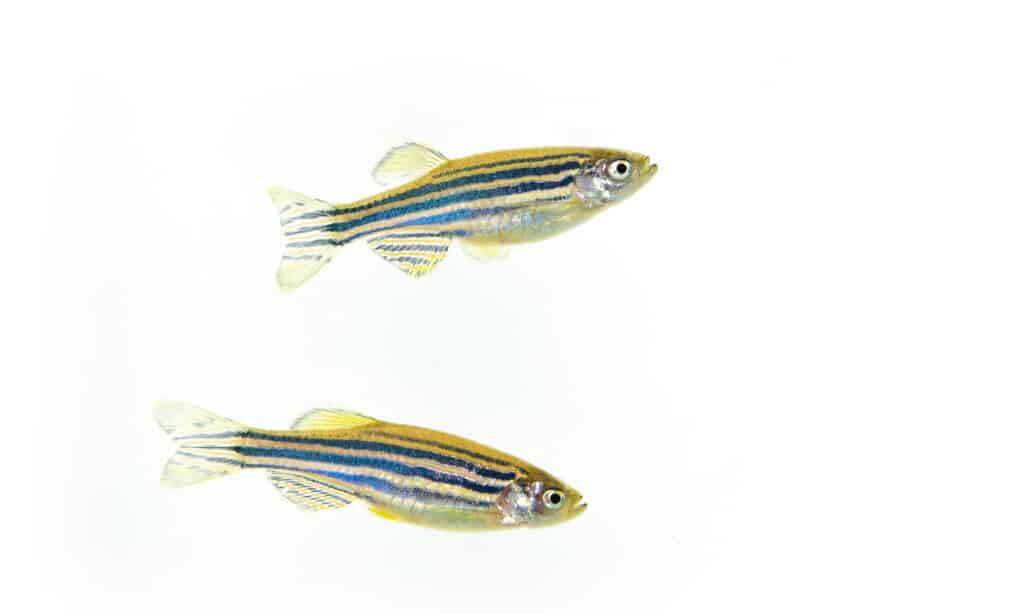
Zebra Danios are small, elongated fish known for their striking striped pattern.
©Horvath82/Shutterstock.com
Kuhli Loach (Pangio kuhlii)
Kuhli Loaches are slender, eel-like fish with distinctive markings. They’re usually brown or black with orange or yellow stripes running along their body. Kuhli Loaches have a reputation for being private creatures. They tend to be most active during the night, preferring to spend their days hiding in caves, plants, or buried in the substrate.
Monitor how Kuhli Loaches and Pea Puffer fish interact. They’re both shy, so maintain a calm environment. If they start fighting, add more hiding spots or rearrange decorations to separate them visually.

Kuhli loaches are part of the Cobitidae family.
©iStock.com/Miropa
Octocinclus Catfish (Octocinclus sp.)
Octocinclus fish enjoy hanging out at the bottom of the tank. They have a mouth that acts like a suction cup, and their body colors usually vary from green to brown with spots. Octocinclu’s main diet includes algae and small organisms that grow on rocks, and plant leaves inside the aquarium.
Even though they are efficient at keeping algae under control, it’s important to supplement their diet with tasty vegetables like zucchini or cucumber.
Neon Tetras (Paracheirodon innesi)
Neon Tetras stand out for their vibrant colors and miniature stature. Their body features a blue and red horizontal line that runs across the tip of their nose all the way to the base of the tail.
In addition, Neon Tetras enjoy snacking on either live or frozen brine shrimp and bloodworms. However, they can also be given nutritious flake and pellet food.
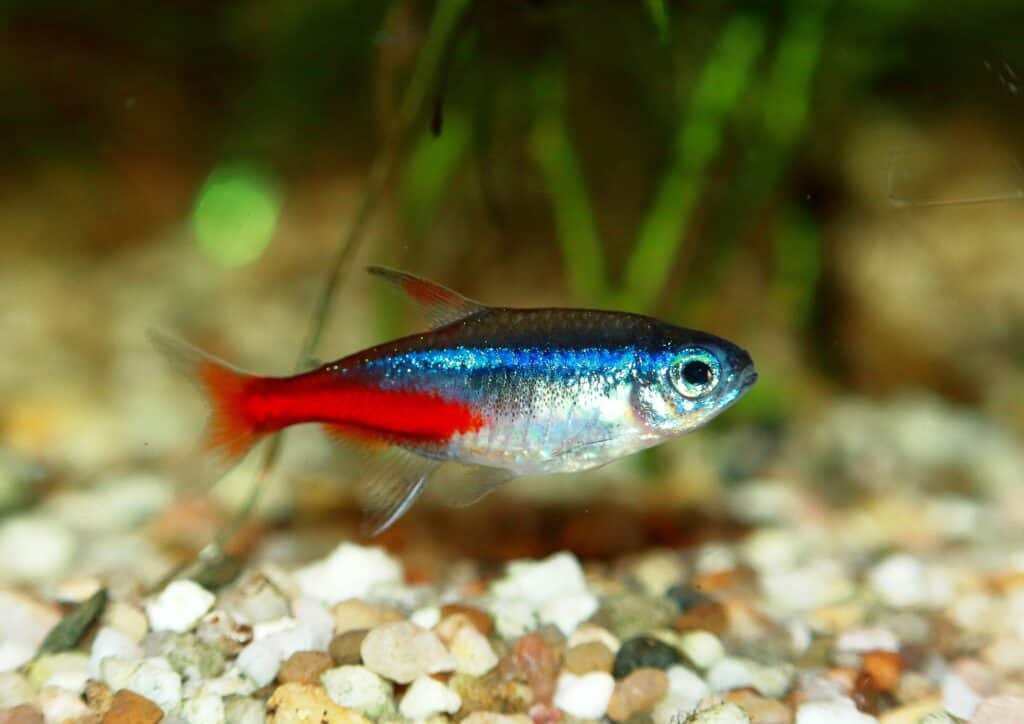
The neon tetra has a light-blue back over a silver-white abdomen and an iridescent red stripe from the middle of the body.
©Kristiana Berzina/Shutterstock.com
Pygmy Corys (Corydoras pygmaeus)
Pygmy fish displays three horizontal stripes that run across its silver-colored form. They are gentle fish that coexist harmoniously with pea puffers. However, it is advisable to avoid placing them in the tank as more aggressive fish could potentially cause them distress.
Pea Puffers like to munch on meaty critters, while Pygmy Corys enjoy algae and bits from the tank’s bottom. Because they have different tastes, they don’t fight for food. Therefore, makes them the ideal tank mates for pea puffer fish.

They are gentle fish that coexist harmoniously with pea puffers.
©Pavaphon Supanantananont/Shutterstock.com
Glowlight Tetra (Hemigrammus erthrozonus)
Glowlight Tetras are greatly admired for their breathtaking beauty. They possess a slender, elongated physique with a silver hue. What truly distinguishes them is a stripe of neon orange that gracefully travels through their body, spanning from their snout to the tip of their tail.
Glowlight Tetras are friendly little fish and prefer living with peaceful fish in a community tank. Because they are tropical fish, it’s advisable to keep a balanced water temperature between 72°F to 78°.
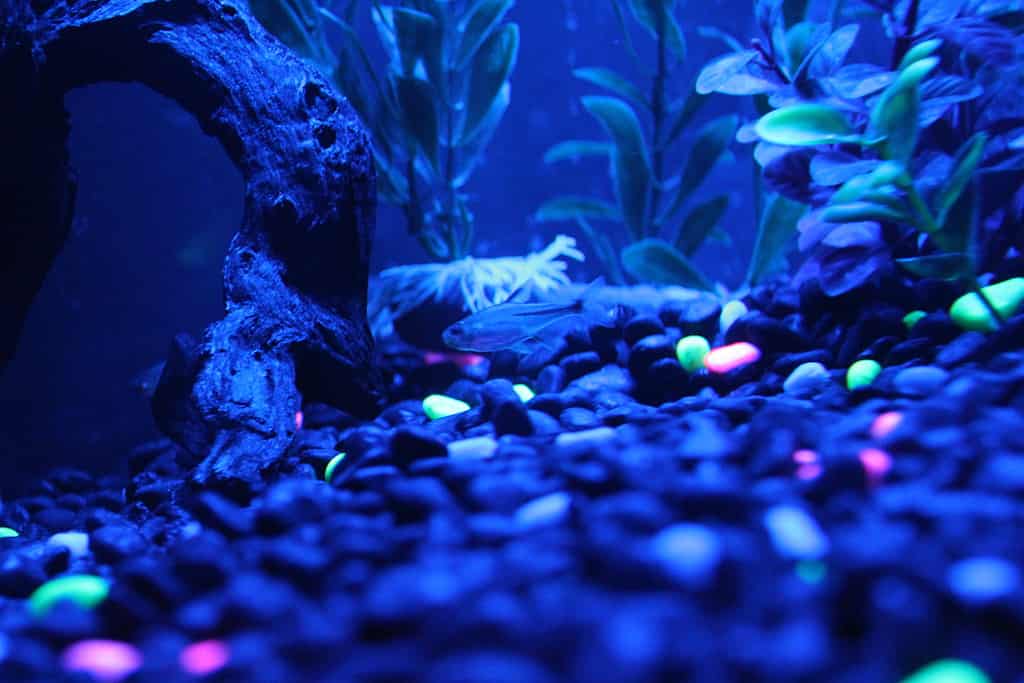
Glowlight tetras get their name from how they look under blacklight.
Siamese Algae Eaters (Crossocheilus oblongus)
Siamese algae eaters have a sleek body shape followed by a striking stripe that runs from their heads all the way to their tails, allowing for effortless identification. These fish are busy scavengers with a big appetite for algae. People often put them in aquariums to help control and get rid of algae. These fish get along well with pea puffer fish.
In addition, create a vegetative aquarium by incorporating plenty of plants, hiding spots, and open spaces for swimming. Siamese algae eaters thrive in a setting that includes driftwood and rocks.

Siamese fish are busy scavengers with a big appetite for algae.
White Cloud Minnow (Tanichthys albonubes)
White Cloud Minnows are fish that live in freshwater. They come in a range of colors, from gold to pale green. Furthermore, their fins are adorned with black patterns. These fish are known for their relaxed nature and can peacefully coexist with other small fish in community aquariums.
These small fish thrive in tanks that offer abundant vegetation and open spaces for swimming and hiding spots. Additionally, they adapt well to cool water conditions, making them an excellent choice for pea puffers and other tank mates, which include minnows, danios, tetras, and rasboras.

©Besjunior/Shutterstock.com
Bristlenose Pleco (Ancistrus cirrhosis)
The Bristlenose Pleco is a sociable fish often found in freshwater aquariums. They have a brown to grey coloration with flat bodies and unique bristle-like appendages on their snouts, particularly noticeable in males. Because they have a fondness for consuming algae, Bristlenose pleco fish are a great fit for managing the growth of algae and keeping the aquarium’s water clean.
If you’re considering housing both Bristlenose Plecos and pea puffers together, it would be wise to create an environment that has many places for them to hide. These tank arrangements make them feel safe and content.
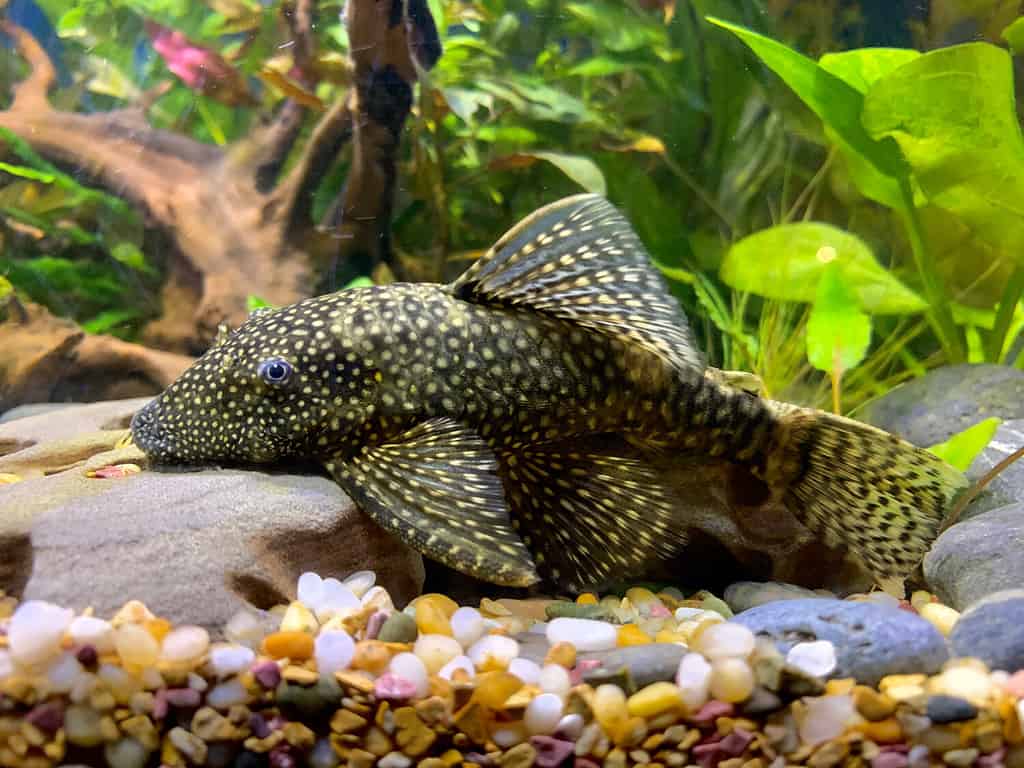
©TTONN/Shutterstock.com
Amano Shrimp (Cardina multidetata)
Amano Shrimp are see-through creatures that have long, delicate antennas. You can easily spot them because of the dots or spots on their sides. What’s great about these shrimps is that they are not aggressive, which makes them for pea puffer fish. They are always in search of food and spend their time cleaning up algae and debris from surfaces and plants inside the tank.
Even though pea puffers and amano shrimp are compatible tank mates, it’s important that your pea puffers are well-fed to prevent them from eating Amano shrimp.
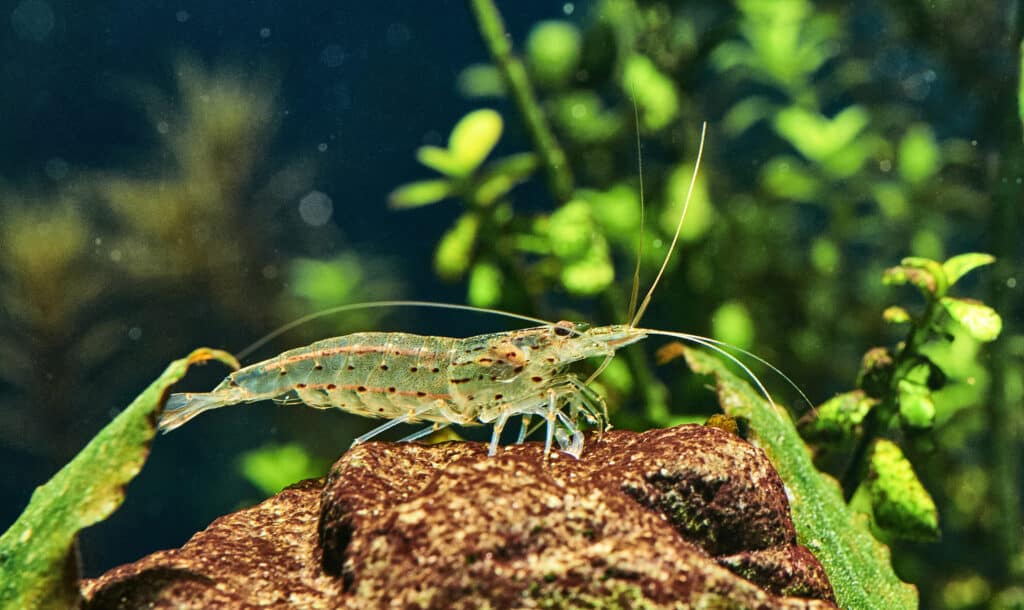
The Amano shrimp spend their time cleaning up algae and debris from surfaces and plants inside the tank.
©Andriy Kotlyarov/Shutterstock.com
Bloodfin Tetra (Aphyocharax anisitsi)
Bloodfin Tetras are prized for their striking red fins, which really catch one’s eye. They have bodies that are either silver or silvery white, followed by a slender and streamlined body shape. These tetras are laidback and friendly, which makes them suitable to swim amongst pea puffer fish. They often gather in groups and enjoy being around fish of their kind or any other calm species that are added to the tank.
In addition, Bloodfin Tetras aren’t too fussy when it comes to their meals. Therefore, they enjoy a selection of food options. This includes high-quality flakes or pellets and frozen treats. Ensuring they have a nutritious diet is key to keeping them healthy and ensuring their colors stay vibrant.
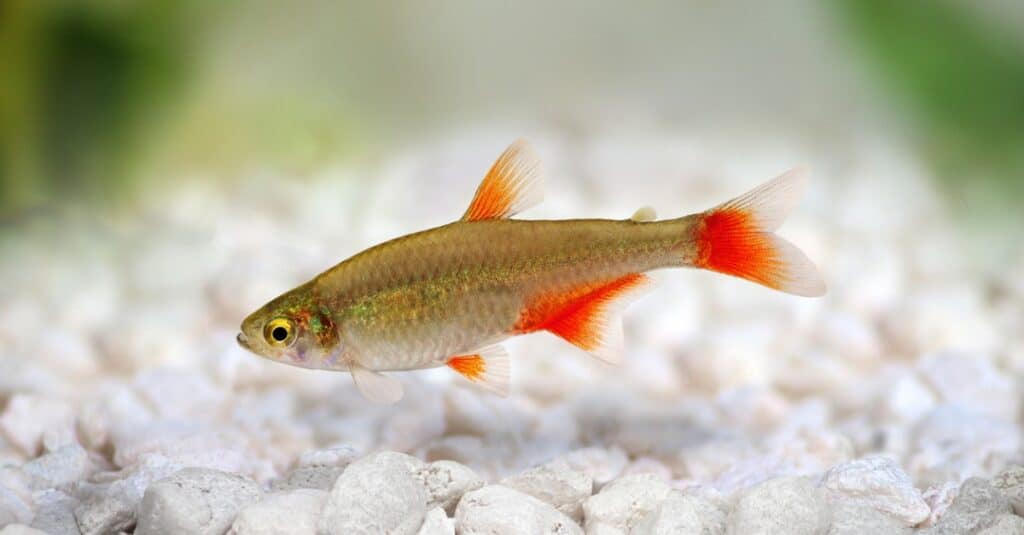
The bloodfin tetra is known for its bright orange fins.
©iStock.com/Mirko_Rosenau
Ember Tetra (Hyphessobrycon amandae)
Ember Tetra fish have a slender and long body. What really makes them unique compared to other species of tetra is their reddish-orange color that covers their whole body. This beautiful coloring makes them an eye-catching choice for any aquarium.
Ember Tetras enjoys being in the company of other playful fish and thrives when kept in groups of five or more. Furthermore, they become very sociable, particularly when they are surrounded by fish of their size.

The bright colors of ember tetras makes them an eye-catching choice for any aquarium.
©nektofadeev/Shutterstock.com
In conclusion
When considering tank mates for your pea puffer fish, it’s important to choose species that have a specific size and temperament. However, it’s crucial to keep an eye on how they interact with each other because pea puffers can sometimes show signs of irritation. If you notice any of the tank mates becoming aggressive towards your pea puffer fish, it’s imperative to have a backup plan.
You should be ready to separate them into separate tanks or provide hiding spots and visual barriers to reduce stress and conflicts. Remember to always prioritize the well-being of your fish and aim for a kindred environment for your aquarium.
The photo featured at the top of this post is © Dan Olsen/Shutterstock.com
Thank you for reading! Have some feedback for us? Contact the AZ Animals editorial team.







